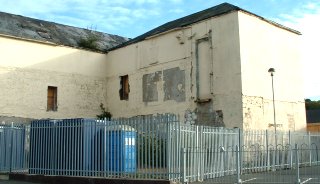The Environment & Heritage Service appointed Ms Claire Foley, Acting Assistant Director, to speak on the McCann’s site excavation and development. We feel it important here …
… to quote verbatim from her ‘letter of explanation to the Friends of Newry Abbey’. Her words are in italics here. We reserve the right also to comment upon them. This letter is dated 11.05.06 and was addressed to The Chairman.
‘Over the past ten years we have … protected it (the site) by controlling development in its vicinity through planning policy’ ……….
Presumably, by handing over the bulk of the site to one of
‘the Council has engaged an architect to oversee this development including any necessary archaeological excavation where ground needs to be disturbed for infrastructure reasons’.
Has Mr Stelfox demanded the return of the plundered ‘Promise Stone’ and other carved granite sculptures previously removed from the site – pieces clearly identified with our earlier Monastery? (Editor’s note: I understand these are now back on display in the museum!).
We understand five small trenches (the reason for each chosen location is not known) were dug, but strangely ..
‘the archaeological excavations failed to find evidence of the vault’
..a thing that architecturally would strongly indicate the building style and period.
‘Failed to find’ since it stopped short of the vault which was filled with earlier rubble!
Indeed these excavations yielded no artefacts or anything else of interest. The bones uncovered in a very shallow grave within the building [at a depth of a few centimetres only, and only because a lift-shaft was scheduled in that place] were sent, for two years, to
How significant is that? Does it not merit further investigation? From what causes did all these people die? Could this be the remains of a number of the displaced monks? Were any non-human organic remains included? Is it not possible to carbon-date organic remains just a few hundred years old somewhat more accurately that ‘100 years either way’? Of course it is!
By far the most significant admission of Ms Foley is her statement – contradicting all those that preceded it, that within, and as an essential part of the recently-renovated building – indeed at first-floor level – was uncovered evidence of an earlier wall: earlier, that is, that the coming of Bagenal to Ireland! Earlier even than the group of burials just alluded to, that Ms Foley confirms are even now not closely dated but span the range from the mid-fifteenth century to the mid-seventeenth century!
Their contention therefore is that Bagenal built from scratch, a castle that somehow includes a pre-existing first-floor (i.e. above ground floor) wall. Amazing!
Indeed it is notable that that earlier date of mid-fifteenth century has been cited by some internet sources as the likely construction date of the Abbot’s House, later Bagenal’s Castle.
Such a breathtaking admission does not, in Ms Foley’s view, constitute an admission of Abbot’s House, per se, for this building.
Indeed, rather pathetically now in our view, she adds ..
”This could be the remains of any building related to this former, very large monastery but there is not enough evidence to say for certain what its function was.’
But it is the Monastery! That is the point the Abbey Friends have made all along!
And wait! We have the evidence of two 1550 Inquisitions. Studiously discounting the possibility that this group of monks (there were at least five then) may have had a large residence, the Inquisitions detail a church, chapter house, dormitory, hall and an orchard and garden.
Do any of those sound likely? Does it matter?
Was it not the Monastery? Is that not the essential point?
Curiously, the AAD of the EHS contends, without citing any source, that ..
‘The Abbey of Newry does seem to have been fairly well destroyed. Its remains may have been reused in creating the stone buildings in the later town.’
Yet the official Newry historian Tony Canavan, in his excellent “Frontier Town – an illustrated history of Newry” (Blackstaff 1989) p. 41 acknowledges that Bagenal occupied the former abbey building which he “castellated for its defence”. This was as late as 1568 and after the death of his mortal enemy Shane O’Neill.
Ms Foley’s letter contains tacit admissions too about the ‘Lythe’ map, and the fiction it propogates, upon which almost all their ‘evidence’ is based.
‘This structure is not actually named on Rocque’s map.’ i.e. it (The massive castle!) had simply ‘disappeared’ by the following century! Got that? ” Bagenal’s Castle” – far and away the largest structure in the whole town of Newry – simply vanished in the following century only to re-emerge in the late twentieth-century to great fanfare from Newry & Mourne Council. The AAD of the EHS continues …
‘This wall .. (to the north-west of ‘Lythe’s’ map, an area of contention between EHS and Abbey Friends) .. is either a real or conjectured town ditch and the buildings it crosses may have pre-dated this’.
Put bluntly, Bagenal apparantly caused to have drawn not Newry as it was, but as it might be, should he be awarded the
